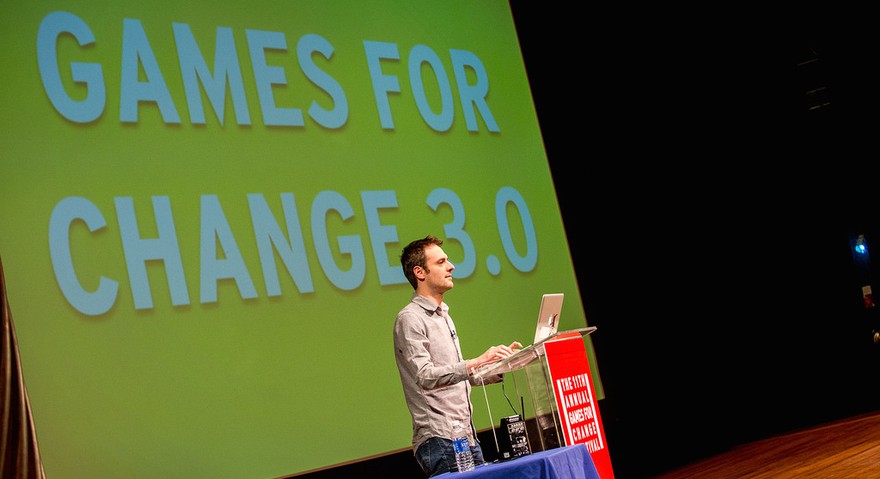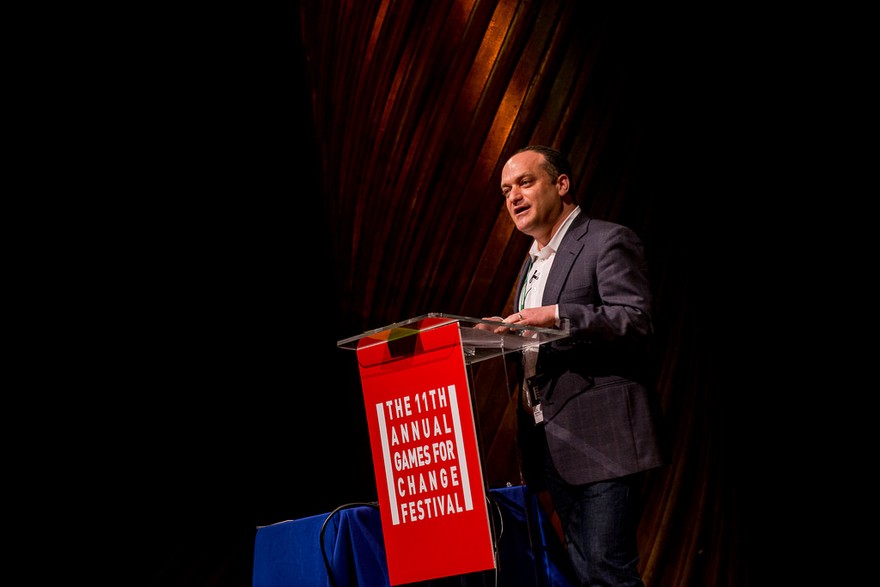While there’s often tremendous spirit and positive forces at work at annualized activism rallies, there’s something a little depressing about them too. The undertone of annualization is, on some level, a concession that whatever the activist push may be, the issue in question won’t be resolved a year from now, thus necessitating another convening 12 months down the road. I used to work on the National Mall in Washington, DC and witnessed these gatherings on a regular basis. This first year is a tremendous showcase of solidarity, and the second year exhibits resolve and dedication. However, the third year passes a point of repetition where, as an outside observer, I wonder what progress is actually being made.
The Games For Change Festival, a three-day conference of talks and awards focusing on the creation and implementation of games for social good, might sound like an activist rally, but it’s really more of an industry get-together with a strong advocacy slant. Given that this was my third consecutive year attending the festival, I don’t think it’s a coincidence that the most resonant presentations for me were the ones that offered institutional critique of the festival and the Games For Change mission at large. The first time you hear about the “power of games to change the world” it’s exciting to see the medium spoken of as important and influential. But the third time you hear the same lines, sometimes even from the same speakers, it actually has a bit of a deflating effect. It’s expected that progress, especially at a vast sociological level, is slow, but part of the promise of so-called “serious games” is that they’ll cut through some of the obstructive bureaucracy that so often slows activism down. I went into the conference wondering whether games for social impact really are “disruptors” (the current buzzword for this brand of activism) or if it’s all just talk.

On the second day of the Games For Change Festival, the man behind Molleindustria (Unmanned, Phone Story), Paolo Pedercini, delivered the most unabashedly critical talk of the conference, openly decrying certain efforts of major players in the serious games industry and questioning the validity of measurable social impact as proof that change has been initiated by games. “If you can measure it, it’s not the change I want to see,” he declared, the same bold text projected behind him. To seek such quantifiable assessment is to “impose prepackaged behavior protocols rather than facilitating critical thought.” Pedercini argued that seeking points of measurability detrimentally narrows the focus of initiatives away from engagement with larger systemic issues in favor of reportable figures that are more attractive to potential donors in what he terms the “non-profit industrial complex.” Ironically, Pedercini’s talk was the session that I felt had the greatest impact on me, measurable or no.
Perhaps part of what Pedercini is getting at stems from Games For Change’s broad definition of “change” itself, framing the term as action made on behalf of “social good.” While such framing is inclusive to a wide range of projects, it does place a certain emphasis on results without necessarily addressing the ethics of how games are being used to achieve them. In several talks during the festival, speakers highlighted research into human behavior and brain functions as means of influencing yourself or others to do as you bid, not by changing minds but by applying outside pressure with gamification tactics. Pedercini’s reaction to this echoed my own skepticism: “If your game or technology really works, in this direct and reductionist way, it freaks the fuck out of me.” After all, isn’t this the same way that junk food companies use color theory to entice me to buy snacks I probably shouldn’t be eating? This may seem reductive, but it’s worth considering the ethical implications of how games can be used to goad players into giving money, even to worthy humanitarian causes, and what the long-term influence of gamified donors could mean for the sustainability of those initiatives.
While not quite so cold on the idea of impact assessment, even the Games For Change Festival itself was on board for a bit of self-evaluation, hosting a panel discussion on the final day that examined what is actually meant by the vague term “change.” Not every social impact game needs to be a teaching tool when goals such as civic labor and group empowerment are equally valid. On the panel, game maker and USC professor Tracy Fullerton posited that while there is a place for impact assessment in the design process, which could be seen as an extension of playtesting, an overreliance on measurable results can stifle creative thinking. Fullerton goes on to discuss how Minecraft, a game with many educational applications in a variety of different fields of study, would never get initial development funding through educational channels because of its emergent properties and lack of predictive outcomes. In fact, as was presented earlier at this very conference, Minecraft is being used by the United Nations in countries including Kenya, Nepal, Sweden, and Haiti to get citizens directly involved in urban planning in their own cities and towns. Who’d have thought?
I’m encouraged by Games For Change’s willingness to look inward (we’re talking about a field that prides itself on iterative design here), but hope the introspection will focus on the processes at hand, not just the measurability of results. After the conference, I asked the President of Games For Change, Asi Burak, how he saw this open criticism fitting into the organization moving forward. He expressed that “this year, more than ever, there was an apparent tension between institutional approaches that put strategy and assessment at the heart of their process vs. artistic and individual voices. We want to steer Games for Change to have more of the latter.” He went on to note that he feels, “as a ‘convener,’ it’s our absolute commitment to present all of the existing models. I believe they can live side by side, and I am also seeing voices that serve as bridges [between these perspectives]. I’m optimistic, but I also acknowledge it’s going to be a challenging process and that we would need to share curation responsibilities with others in order to make it happen.”

In the conclusion of his talk, Paolo Pedercini suggested that using game design as an educational tool instead of a medium for merely delivering educational content could be a more effective method for engaging students with social impact subjects. Demystifying the process behind game design makes players more astute critics of games and potentially of all culture, too. After attending the Games For Change Festival three years in a row, I’ve become increasingly clued-in to the intricacies of the social impact games movement. I’m no longer wowed by the flashier, TED-ready presentations and am better equipped to appreciate sessions that spotlight flaws and accomplishments in equal measure. I don’t know how one would measure that kind of personal change, but I’ll attest that it occurred nonetheless. And even though I was left with the reinforced belief that games can indeed change minds, it stands to reason that minds can also change about games. So, see you next year?
